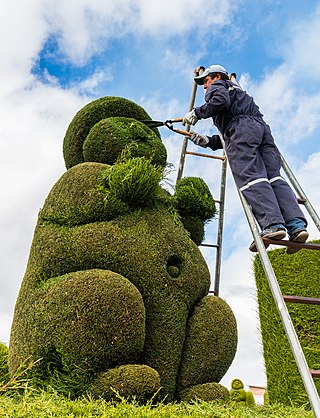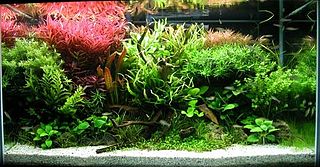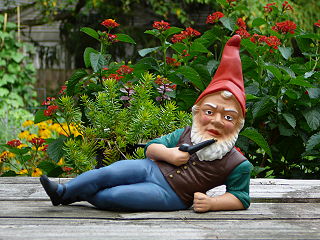
Gardening is the process of growing plants for their vegetables, fruits, flowers, herbs, and appearances within a designated space. Gardens fulfill a wide assortment of purposes, notably the production of aesthetically pleasing areas, medicines, cosmetics, dyes, foods, poisons, wildlife habitats, and saleable goods. People often partake in gardening for its therapeutic, health, educational, cultural, philosophical, environmental, and religious benefits.

Raised-bed gardening is a form of gardening in which the soil is raised above ground level and usually enclosed in some way. Raised bed structures can be made of wood, rock, concrete or other materials, and can be of any size or shape. The soil is usually enriched with compost.

A garden is a planned space, usually outdoors, set aside for the cultivation, display, and enjoyment of plants and other forms of nature. The single feature identifying even the wildest wild garden is control. The garden can incorporate both natural and artificial materials.

A parterre is a part of a formal garden constructed on a level substrate, consisting of symmetrical patterns, made up by plant beds, plats, low hedges or coloured gravels, which are separated and connected by paths. Typically it was the part of the garden nearest the house, perhaps after a terrace. The view of a parterre from inside the house, especially from the upper floors, was a major consideration in its design. The word "parterre" was and is used both for the whole part of the garden containing parterres and for each individual section between the "alleys".

A terrace garden is a garden with a raised flat paved or gravelled section overlooking a prospect. A raised terrace keeps a house dry and provides a transition between the hardscape and the softscape.

William Robinson: was an Irish practical gardener and journalist whose ideas about wild gardening spurred the movement that led to the popularising of the English cottage garden, a parallel to the search for honest simplicity and vernacular style of the British Arts and Crafts movement, and were important in promoting the woodland garden. Robinson is credited as an early practitioner of the mixed herbaceous border of hardy perennial plants, a champion too of the "wild garden", who vanquished the high Victorian pattern garden of planted-out bedding schemes. Robinson's new approach to gardening gained popularity through his magazines and several books—particularly The Wild Garden, illustrated by Alfred Parsons, and The English Flower Garden.
Garden design is the art and process of designing and creating plans for layout and planting of gardens and landscapes. Garden design may be done by the garden owner themselves, or by professionals of varying levels of experience and expertise. Most professional garden designers have some training in horticulture and the principles of design. Some are also landscape architects, a more formal level of training that usually requires an advanced degree and often a state license. Amateur gardeners may also attain a high level of experience from extensive hours working in their own gardens, through casual study, serious study in Master gardener programs, or by joining gardening clubs.

A paver is a paving stone, tile, brick or brick-like piece of concrete commonly used as exterior flooring. They are generally placed on top of a foundation which is made of layers of compacted stone and sand. The pavers are placed in the desired pattern and the space between pavers is then filled with a polymeric sand. No actual adhesive or retaining method is used other than the weight of the paver itself except edging. Pavers can be used to make roads, driveways, patios, walkways and other outdoor platforms.

Hardscape is hard landscape materials in the built environment structures that are incorporated into a landscape. This can include paved areas, driveways, retaining walls, sleeper walls, stairs, walkways, and any other landscaping made up of hard wearing materials such as wood, stone, and concrete, as opposed to softscape, the horticultural elements of a landscape.

The cottage garden is a distinct style that uses informal design, traditional materials, dense plantings, and a mixture of ornamental and edible plants. English in origin, it depends on grace and charm rather than grandeur and formal structure. Homely and functional gardens connected to cottages go back centuries, but their stylized reinvention occurred in 1870s England, as a reaction to the more structured, rigorously maintained estate gardens with their formal designs and mass plantings of greenhouse annuals.

Aquascaping is the craft of arranging aquatic plants, as well as rocks, stones, cavework, or driftwood, in an aesthetically pleasing manner within an aquarium—in effect, gardening under water. Aquascape designs include a number of distinct styles, including the garden-like Dutch style and the Japanese-inspired nature style. Typically, an aquascape houses fish as well as plants, although it is possible to create an aquascape with plants only, or with rockwork or other hardscape and no plants.

Roman gardens and ornamental horticulture became highly developed under Roman civilization, and thrived from 150 BC to 350 AD. The Gardens of Lucullus, on the Pincian Hill in Rome, introduced the Persian garden to Europe around 60 BC. It was seen as a place of peace and tranquillity, a refuge from urban life, and a place filled with religious and symbolic meaning. As Roman culture developed and became increasingly influenced by foreign civilizations, the use of gardens expanded.
The term hard landscape is used by practitioners of landscape architecture and garden design to describe the construction materials which are used to improve a landscape by design. The corresponding term soft landscape materials is used to describe vegetative materials such as plants, grasses, shrubs, trees, etc. to improve landscape or outdoor space.

A garden ornament or lawn ornament is a non-plant item used for garden, landscape, and park enhancement and decoration.
This is an alphabetical index of articles related to gardening.

The Generalife was a summer palace and country estate of the Nasrid rulers of the Emirate of Granada in Al-Andalus. It is located directly east of and uphill from the Alhambra palace complex in Granada, Spain.

A Colonial Revival garden is a garden design intended to evoke the garden design typical of the Colonial period of Australia or the United States. The Colonial Revival garden is typified by simple rectilinear beds, straight pathways through the garden, and perennial plants from the fruit, ornamental flower, and vegetable groups. The garden is usually enclosed, often by low walls, fences, or hedges. The Colonial Revival gardening movement was an important development in the gardening movement in the United States.

Ixora coccinea is a species of flowering plant in the family Rubiaceae. It is a common flowering shrub native to Southern India, Bangladesh, and Sri Lanka. It has become one of the most popular flowering shrubs in South Florida gardens and landscapes. It is the national flower of Suriname. Commercially important medicinal plant, used in ayurveda. All parts including flower, leaves and root are taken for various medicinal preparations for skin disease, Diabetes etc.

Bedrock Gardens is a 20-acre (8.1 ha) garden located on a 35-acre (14 ha) property in Lee, New Hampshire, notable for its landscape design, its horticulture and its sculpture.
Sustainable landscaping is a modern type of gardening or landscaping that takes the environmental issue of sustainability into account. According to Loehrlein in 2009 this includes design, construction and management of residential and commercial gardens and incorporates organic lawn management and organic gardening techniques.















